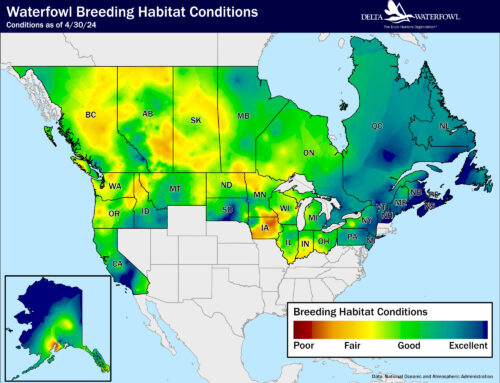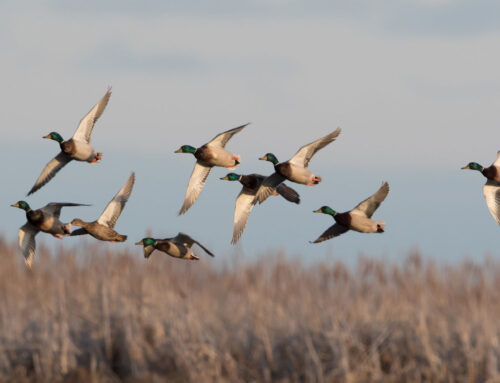California Drought Washed Away
Plentiful precipitation should have Golden State duck hunters smiling

By Paul Wait

The rice fields are green again in California.
A brutal three-year drought that left hundreds of thousands of acres of crop fields dusty and barren in California’s fertile Sacramento Valley has abated. Last winter, an unusual weather pattern unleashed more than a dozen atmospheric rivers—wind-driven storms that form over the ocean—drenching the valley with rains and dumping more than twice as much snow than normal on the nearby Sierra Nevada mountains. Through June 1, 753.5 inches (62.8 feet) of snow had fallen at the University of California Berkley Central Sierra Snow Laboratory for the current meteorological year, making it the second-snowiest winter on record since 1946.
“We have water, and every single field we have will be planted,” said Mark Kirsten, manager of the Davis Ranch, a 5,500-acre farming operation near Colusa, California.
The Davis Ranch has 3,800 acres of rice cultivated and growing.
“Last year, it was a dust bowl. We had 18 acres of seed rice and thousands of acres of dry dirt,” Kirsten said. “As usual with California’s weather patterns, it’s feast or famine.”
Sacramento Valley agricultural producers depend on water allocations from the Shasta and Oroville reservoirs. Water is a valuable commodity in California. For the 2022 growing season, water allocations were cut to 18 percent of normal, idling more than half of the region’s rice fields.
Water allocations for agriculture are 100 percent for 2023, and as the mountain snowpack continues to melt, both reservoirs are 98 percent full and dumping excess water into the Sacramento River.
“I did not expect in my wildest dreams that we would get 100 percent water allocation this year, but it just kept raining for four months straight,” Kirsten said.
Just over 250,000 acres of rice was planted in 2022, according to Kristin Sesser, wildlife programs manager for the California Rice Commission. Although numbers are not final, the CRC expects 475,000 acres of rice this year, much closer to the historical average of 500,000 acres.
“Most farmers this year have planted every acre of rice they can,” Sesser said. “Everyone is breathing a sigh of relief after the drought. We have a lot of rice in areas where we normally have it, and we expect normal winter flooding post-harvest this year. And that’s good news for wildlife and duck hunters.”
The return of normal water levels and a lush landscape loaded with rice in the Sacramento Valley benefits breeding ducks now, and certainly will provide excellent wintering habitat for waterfowl and other migratory birds. An estimated 7 to 10 million ducks and geese migrate to and through the region each fall, taking full advantage of the bounty of waste grain and flooded ag fields.
Kirsten has observed a dramatic increase in the numbers of nesting ducks at the Davis Ranch this spring. He reported that most of the wood duck nest boxes on the farm were occupied, and he spotted more mallards and cinnamon teal in the ditches. Marshes in the nearby California foothills region have refilled and recharged, too.
An avid waterfowl hunter, Kirsten also runs the Sebia Duck Club on 1,400 acres of rice fields on the Davis Ranch. With abundant rice and plenty of water to keep it flooded after harvest, Kirsten anticipates a strong season ahead for his club, as well as for waterfowl hunters throughout the region.
“We will hear the happy cackles of the whitefronts (geese) when they hit the west side of the valley this fall,” Kirsten said.
Mike Cole, a rice farmer and duck club owner from Yuba City, California, said the deluge of rain meant some of California’s rice farmers were unable to get their fields prepped in time to plant this spring. Ironically, those fields were flooded under too much water, and the farmers couldn’t level their fields and get the fertilizer on in time to plant a crop this year. But Cole’s rice crop is seeded.
After a rough season at his duck club last season, Cole said his crew of hunters is ready for a reversal of fortune.
“It should be a much better duck season than last year,” Cole said. “We’ll have flooded rice fields with waste grain, and the refuges will have water and food, too. We’re already looking forward to duck season this fall.”







Leave A Comment